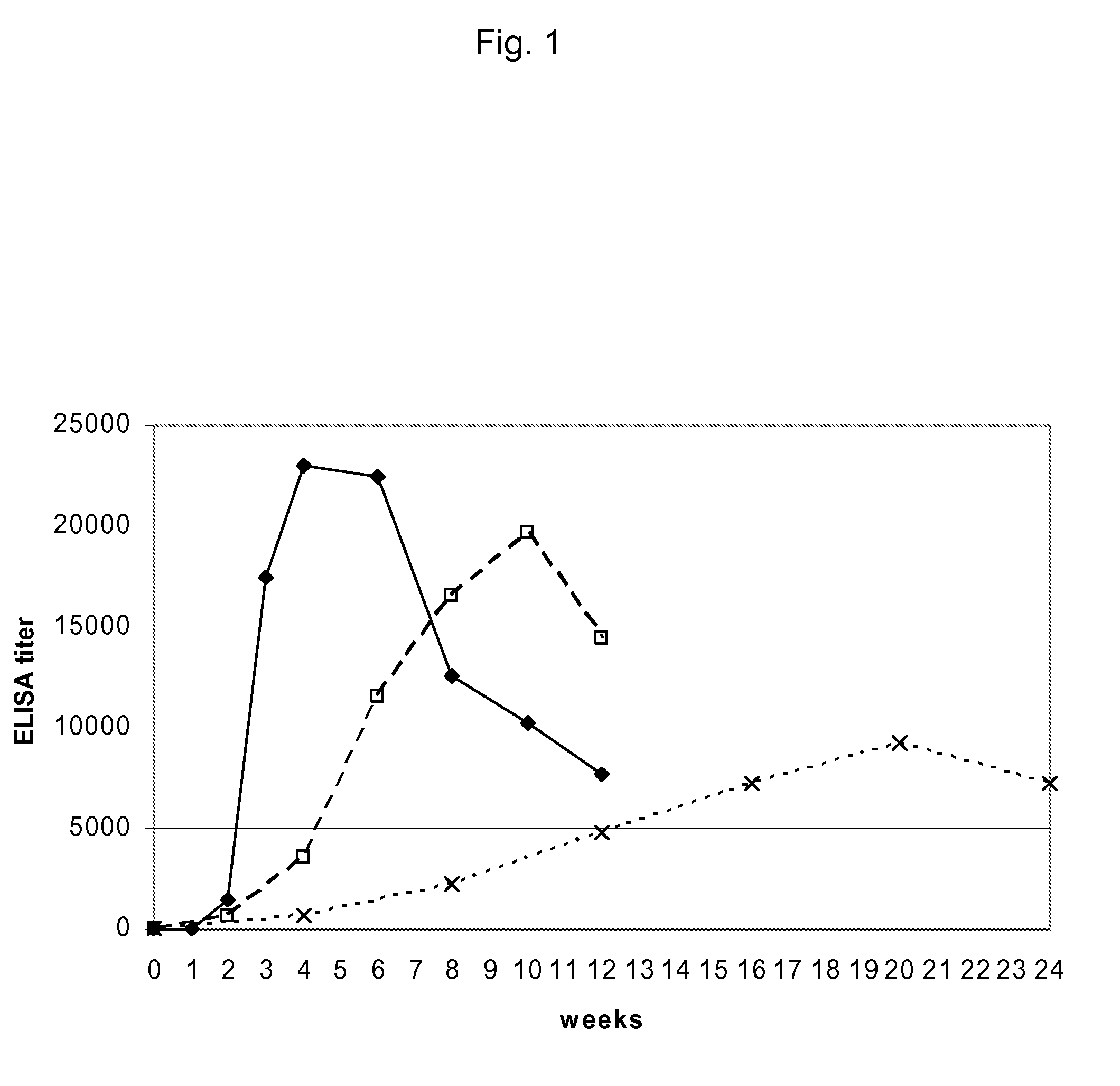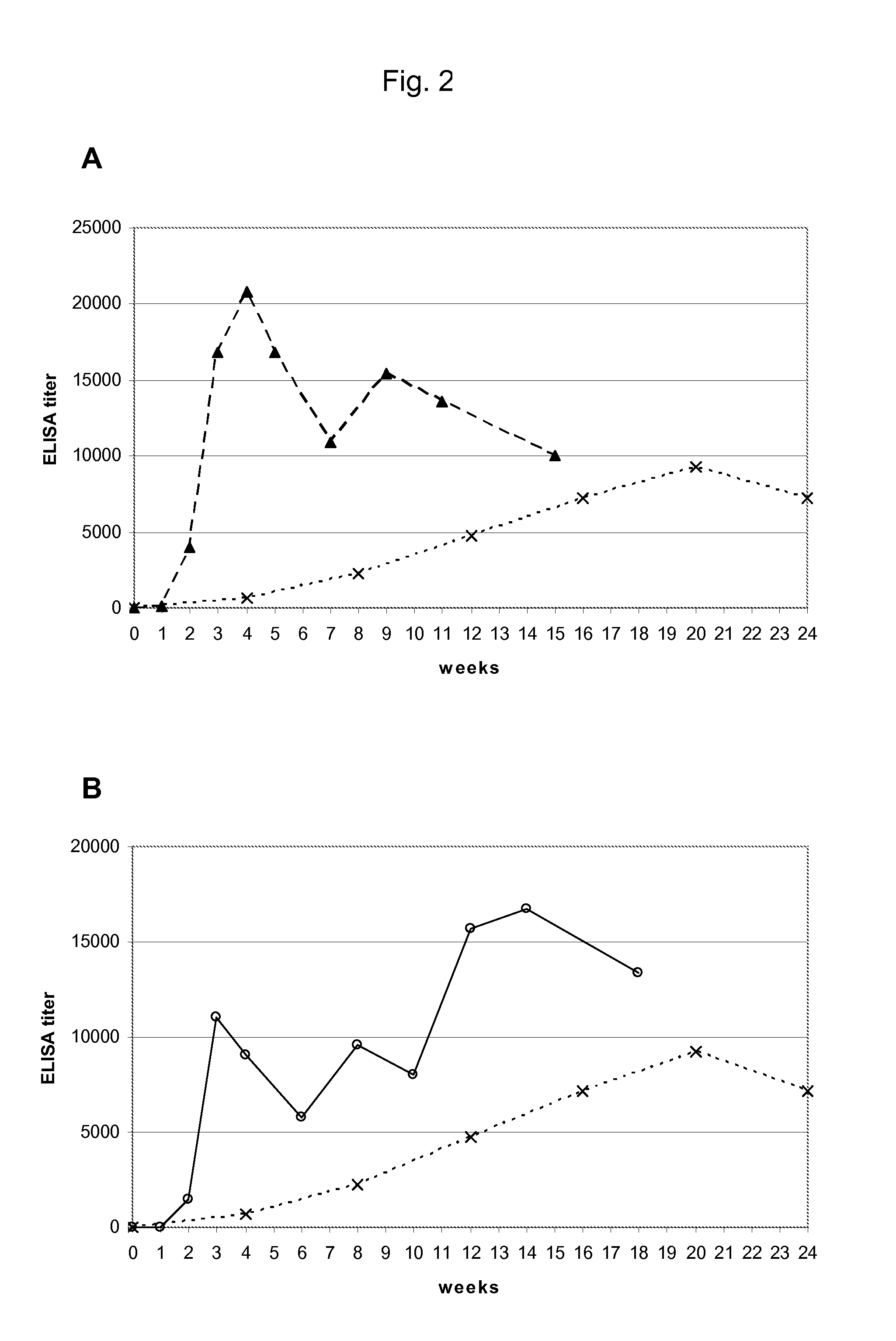Vaccination Regimen for B-Cell Vaccines
- Summary
- Abstract
- Description
- Claims
- Application Information
AI Technical Summary
Benefits of technology
Problems solved by technology
Method used
Image
Examples
example 1
[0066]“NicQβ”—The term “NicQβ”, as used herein should refer to at least one nicotine-VLP conjugate comprising (a) a virus-like particle of RNA bacteriophage Qβ; and (b) at least one nicotine molecule, wherein the nicotine molecule is covalently bound to VLP of Qβ by a linking sequence, wherein said linking sequence consists of A-CH2OCO(CH2)2CO—B, and wherein A represents said nicotine molecule and wherein B represents the VLP of Qβ, and wherein the linking sequence is covalently bound to the 3′ position of the nicotine molecule. NicQβ was produced as described in EXAMPLE 1 of U.S. Pat. No. 6,932,971. NicQβ drug substance was thawed at room temperature (regimen 1) or reconstituted with sterile water from a freeze-dried powder followed by the addition of an adjuvant Alhydrogel™ containing aluminum hydroxide [Al(OH)3].
[0067]The final vaccine composition ready for administration, designated as “100 μg-dose”, containing 100 μg of NicQβ and 1.3 mg of aluminum hydroxide.
example 2
[0068]Regimen 1: Subject received five doses prepared as described in Example 1. The time interval between the administrations was 28 days
[0069]Regimen 2: Substantially the same as Regimen 1 with the exception that the time interval between the administrations was 14 days.
[0070]Regimen 3: Substantially the same as Regimen 1 with the exception that the time interval between the administrations was 7 days.
[0071]FIG. 1: Comparison of weekly, biweekly and monthly vaccination regimen:
[0072]Blood samples were collected at the time points as indicated in FIG. 1 for the measurement of anti-nicotine antibody titers to evaluate the immunogenicity of the particular dosing regimen. Anti-nicotine IgG antibody titer was determined by ELISA using well plates coated with RNAse-nicotine conjugate. The geometric mean values of antibody titers were shown in FIG. 1. The antibody binding affinity to nicotine was determined by equilibrium dialysis.
[0073]While with regimen 1 the highest antibody titer was...
example 3
[0076]Regimen 4: Subject received five doses prepared as described in Example 1. The time interval between the first three administrations was 7 days followed by two administrations in 28 days intervals
[0077]Regimen 5: Subject received five doses prepared as described in Example 1. The time interval between the first four administrations was 7 days followed by one administration in a 28 days interval
[0078]FIGS. 2A and 2B: Comparison of Regimen 4 and Regimen 5 and the monthly vaccination regimen:
[0079]Blood samples were collected at the time points as indicated in FIG. 2 for the measurement of anti-nicotine antibody titers to evaluate the immunogenicity of the particular dosing regimen. Anti-nicotine IgG antibody titer was determined by ELISA using well plates coated with RNAse-nicotine conjugate. The geometric mean values of antibody titers were shown in FIG. 2. The antibody binding affinity to nicotine was determined by equilibrium dialysis.
[0080]While with regimen 1 the highest an...
PUM
| Property | Measurement | Unit |
|---|---|---|
| Time | aaaaa | aaaaa |
| Time | aaaaa | aaaaa |
| Time | aaaaa | aaaaa |
Abstract
Description
Claims
Application Information
 Login to View More
Login to View More - R&D
- Intellectual Property
- Life Sciences
- Materials
- Tech Scout
- Unparalleled Data Quality
- Higher Quality Content
- 60% Fewer Hallucinations
Browse by: Latest US Patents, China's latest patents, Technical Efficacy Thesaurus, Application Domain, Technology Topic, Popular Technical Reports.
© 2025 PatSnap. All rights reserved.Legal|Privacy policy|Modern Slavery Act Transparency Statement|Sitemap|About US| Contact US: help@patsnap.com


